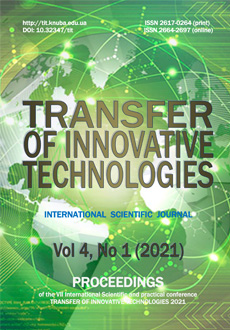Analysis of crowdsourcing technology tasks for geoinformation systems in the field of emergency management
DOI:
https://doi.org/10.32347/tit2141.0304Keywords:
overcoming the consequences of emergencies, emergency managementAbstract
In recent decades, there has been a trend of increasing the number of emergencies (EM) and the scale of their consequences. This forces humanity to look for new ways to increase the effectiveness of protection of the population and territories from emergencies, to anticipate future threats, risks and dangers, to develop methods for their forecasting and prevention [1]. Emergencies are always accompanied by both material and human losses, so it is very important to make quick and correct decisions to eliminate their consequences. One of the main areas of improving the efficiency, validity and quality of management decisions to prevent and eliminate emergencies is the creation of information systems to support decision-making based on broad and comprehensive automation of resource management processes, which are designed to prevent and eliminate emergencies. Peculiarities of the decision-making process in emergency situations are incomplete and unreliable presentation of information and a small reserve of time for decision-making, and the peculiarity of the functioning of information systems to support decision-making in emergency situations is the need to ensure adequate and effective modeling of different classes NS. The use of modeling in the management of complex objects of different physical nature, operating, as a rule, in conditions of uncertainty, can significantly increase the efficiency of management due to the fact that provides the ability to analyze changes in the properties of the object when choosing control influences. Given the above, information systems to support decision-making can be supplemented by systems for the rapid collection of information about the state of the environment in emergency areas. Today, the management of the acquisition, integration and analysis of large and heterogeneous data obtained from various sources is carried out on the basis of a new paradigm of computing, called crowdsourcing, and one of the options for obtaining information about the state of the environment in emergency zones there are crowdsourcing systems [2]. Such systems will be able to provide up-to-date information on the state of the environment in the emergency zone, on the basis of which the decision support system will be able to provide the necessary management decisions to prevent, reduce or eliminate negative consequences. Thus, the urgent task of supporting management decisions to improve the efficiency and validity of measures to prevent and eliminate emergencies is the creation of information crowdsourcing systems for collecting information about the state of the environment in emergency areas.
References
Геловани В.А., Башлыков А.А., Бритков В.Б., Вязилов Е.Д. (2001) Интеллектуальные системы поддержки принятия решений в нештатных ситуаціях. М.: Эдитори-ал УРСС, 304.
Тегин В.А., Усманов Б.Ф. (2012) Краудсорсинг в генерации инновационных идей. Мир транспорта, 6, 118-123.
Джефф Хау (2012) Краудсорсинг. Коллек-тивный разум как инструмент развития бизнеса: пер. с английского. М.: Альпина Паблишер, 288.
Сурмин Ю.П., Туленков Н.В. (2004) Теория социальных технологий. К.: МАУП, 608.
Патрушев В.И. (2008) Основы общей тео-рии социальных технологий. М.: ИКАР, 320.
Шкляр В.О. (2017) Застосування краудсо-рсингових систем для підтримки прийнят-тя рішень в умовах ризику та невизначе-ності виникнення надзвичайних ситуацій. Проблеми інфокомунікацій : Матеріали першої всеукраїнської науково-технічної конференції. – Полтава: ПолтНТУ; Київ: НТУ; Харків: НТУ«ХПІ»; Київ: Полтава: ВКСС ВІТІ, 67-68.
Забезпечення інституційних основ підтримки прийняття рішень щодо попередження, реагування та ліквідації наслідків надзвичайних ситуацій [електрон. ре-сурс]. URL: http://komekolog.rada.gov.ua/print/73297.html (дата звернення 15.05.2021).
Downloads
Published
How to Cite
Issue
Section
License

This work is licensed under a Creative Commons Attribution-NonCommercial-NoDerivatives 4.0 International License.
Our journal abides by the CREATIVE COMMONS copyright rights and permissions for open access journals.
Authors, who are published in this journal, agree to the following conditions:
1. The authors reserve the right to authorship of the work and pass the first publication right of this work to the journal under the terms of a Creative Commons Attribution License, which allows others to freely distribute the published research with the obligatory reference to the authors of the original work and the first publication of the work in this journal.
2. The authors have the right to conclude separate supplement agreements that relate to non-exclusive work distribution in the form in which it has been published by the journal (for example, to upload the work to the online storage of the journal or publish it as part of a monograph), provided that the reference to the first publication of the work in this journal is included.




